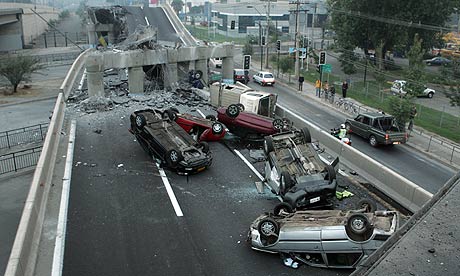by David Batty
Islands evacuate coastal areas as Chilean president declares state of catastrophe after deadly quake of magnitude 8.8

A collapsed highway near Santiago after an earthquake hit Chile. Photograph: David Lillo/AP
A wide array of Pacific nations, including the US, Australia, the Phillipines to Japan, are bracing for potentially devastating tidal waves after a massive earthquake in Chile triggered a tsunami which is radiating across the ocean.
The quake, with a magnitude of 8.8, has already killed at least 120 people in mainland Chile and prompted the evacuation of coastal areas on Easter Island – famous for its monumental stone statues – as well as Samoa and American Samoa.
Countries across the Asia-Pacific region are readying emergency measures drawn up after the Indian Ocean quake of 2004, with the tsunami expected to hit in the next 24 hours.
Michelle Bachelet, the outgoing Chilean president, declared a "state of catastrophe" in central Chile and said a huge tidal wave had swept into the Juan Fernandez Islands. Local radio stations reported serious damage on the archipelago, which reputedly inspired the novel Robinson Crusoe.
The president-elect, Sebastian Pinera, said more than 120 people had died in the quake, and the toll was rising quickly. Bachelet said there were more than 85 deaths just in the Maule region, at the quake's epicentre.
"We have had a huge earthquake with some aftershocks. We're doing everything we can with all the forces we have. Any information we will share immediately. Without a doubt, with an earthquake of this magnitude, there will be more deaths," Bachelet said.
Chile's interior minister, Edmundo Perez Yoma, said: "It has been a devastating earthquake. The death toll will continue rising."
Warnings of tidal waves were issued in 53 other countries. The Pacific tsunami warning centre said the quake had generated a wave that could cause destruction along nearby shores "and could also be a threat to more distant coasts". It issued a tsunami warning for Chile, Peru and Hawaii, while Ecuador, Colombia, Panama, Costa Rica and Antarctica are also on alert.
"Chile probably got the brunt force of the tsunami already. So probably the worst has already happened in Chile," said Victor Sardina, geophysicist at the centre. "The tsunami was pretty big too. We reported some places around 8ft. And it's quite possible it would be higher in other areas."
The centre warned that waves up to 4.8 metres high could hit the coasts of the Hawaiian islands, with the first reaching Hawaii at 9pm GMT. "Urgent action should be taken to protect lives and property," the centre said in a bulletin. "All shores are at risk no matter which direction they face."
It said the first waves after a quake were not necessarily the largest, and wave heights were difficult to predict because they can vary significantly along a coast due to the local topography.
Chile's navy said officials had lifted the tsunami warning in southern Chile, local radio reported. The Joint Australian tsunami warning centre warned of a "potential tsunami threat" to the states of New South Wales and Queensland, Lord Howe Island and Norfolk Island.
The quake, which shook buildings as far away as Argentina, was centred 200 miles south-west of Santiago at a depth of 22 miles, according to the US Geological Survey (USGS). It reported 11 aftershocks, five of them measuring 6.0 or above, in the two and a half hours following the quake. The epicentre was 70 miles from Concepcion, Chile's second largest city, with a population of about 670,000.
The USGS warned that an earthquake of magnitude 8 or above could cause "tremendous damage". The quake that devastated Haiti's capital, Port-au-Prince, in January was magnitude 7.0.
Santiago's international airport was forced to close, a highway bridge collapsed and rubble from damaged buildings fell on to the streets. Speaking to a local television station in Temuco, one witness said: "Never in my life have I experienced a quake like this, it's like the end of the world."
Chile is at a high risk of earthquakes because it lies on the boundary between the Pacific and South American tectonic plates. According to seismologists, there is usually about one quake of magnitude eight or more a year, and one reaching 8.8 would be expected only every few years.
Dr Brian Baptie, of the British Geological Survey, said: "In global terms this is a very rare quake. Chile has experienced some very big quakes in the past. It was about 124 miles north-east of the largest earthquake ever recorded – 9.5, in 1960 – which resulted in a destructive tsunami that killed many thousands of people around the Pacific."
He said a 1.3-metre tsunami wave was observed at Valparaiso about 20 minutes after the earthquake. "Tsunami waves in the deep ocean travel about the same speed as a jet plane and would take about 15 hours to reach Hawaii and about 20 hours to reach the other side of the Pacific," he said.
Dr David Rothery, senior lecturer at the Open University's department of earth and environmental sciences, said the tsunami was "now radiating away from the epicentre and travelling at several hundred kilometres per hour across the Pacific ocean".
The largest earthquake ever recorded struck the same area of Chile on 22 May 1960. The magnitude-9.5 quake killed 1,655 people and left 2 million homeless, and caused a tsunami that killed people in Hawaii, Japan and the Philippines.
That tsunami was about one to four metres in height, according to Japan's meteorological agency. It said the tsunami from today's quake was likely to be much smaller.

No comments:
Post a Comment